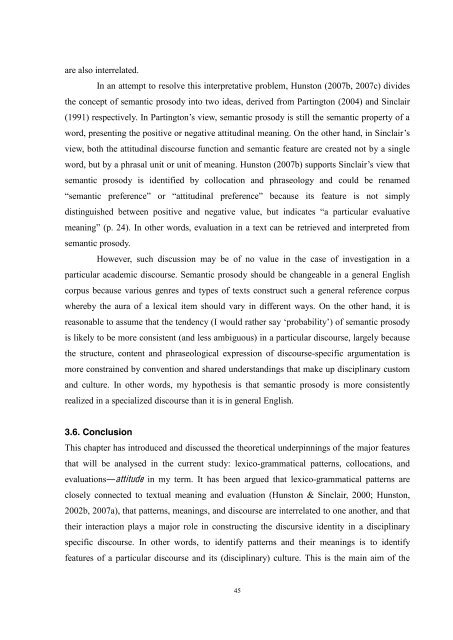Evaluative Meanings and Disciplinary Values - eTheses Repository ...
Evaluative Meanings and Disciplinary Values - eTheses Repository ...
Evaluative Meanings and Disciplinary Values - eTheses Repository ...
You also want an ePaper? Increase the reach of your titles
YUMPU automatically turns print PDFs into web optimized ePapers that Google loves.
are also interrelated.<br />
In an attempt to resolve this interpretative problem, Hunston (2007b, 2007c) divides<br />
the concept of semantic prosody into two ideas, derived from Partington (2004) <strong>and</strong> Sinclair<br />
(1991) respectively. In Partingtons view, semantic prosody is still the semantic property of a<br />
word, presenting the positive or negative attitudinal meaning. On the other h<strong>and</strong>, in Sinclairs<br />
view, both the attitudinal discourse function <strong>and</strong> semantic feature are created not by a single<br />
word, but by a phrasal unit or unit of meaning. Hunston (2007b) supports s view that<br />
semantic prosody is identified by collocation <strong>and</strong> phraseology <strong>and</strong> could be renamed<br />
semantic preference or attitudinal preference because its feature is not simply<br />
distinguished between positive <strong>and</strong> negative value, but indicates a particular evaluative<br />
meaning (p. 24). In other words, evaluation in a text can be retrieved <strong>and</strong> interpreted from<br />
semantic prosody.<br />
However, such discussion may be of no value in the case of investigation in a<br />
particular academic discourse. Semantic prosody should be changeable in a general English<br />
corpus because various genres <strong>and</strong> types of texts construct such a general reference corpus<br />
whereby the aura of a lexical item should vary in different ways. On the other h<strong>and</strong>, it is<br />
reasonable to assume that the tendency (I would rather say probability) of semantic prosody<br />
is likely to be more consistent (<strong>and</strong> less ambiguous) in a particular discourse, largely because<br />
the structure, content <strong>and</strong> phraseological expression of discourse-specific argumentation is<br />
more constrained by convention <strong>and</strong> shared underst<strong>and</strong>ings that make up disciplinary custom<br />
<strong>and</strong> culture. In other words, my hypothesis is that semantic prosody is more consistently<br />
realized in a specialized discourse than it is in general English.<br />
3.6. Conclusion<br />
This chapter has introduced <strong>and</strong> discussed the theoretical underpinnings of the major features<br />
that will be analysed in the current study: lexico-grammatical patterns, collocations, <strong>and</strong><br />
evaluationsattitude in my term. It has been argued that lexico-grammatical patterns are<br />
closely connected to textual meaning <strong>and</strong> evaluation (Hunston & Sinclair, 2000; Hunston,<br />
2002b, 2007a), that patterns, meanings, <strong>and</strong> discourse are interrelated to one another, <strong>and</strong> that<br />
their interaction plays a major role in constructing the discursive identity in a disciplinary<br />
specific discourse. In other words, to identify patterns <strong>and</strong> their meanings is to identify<br />
features of a particular discourse <strong>and</strong> its (disciplinary) culture. This is the main aim of the<br />
45
















